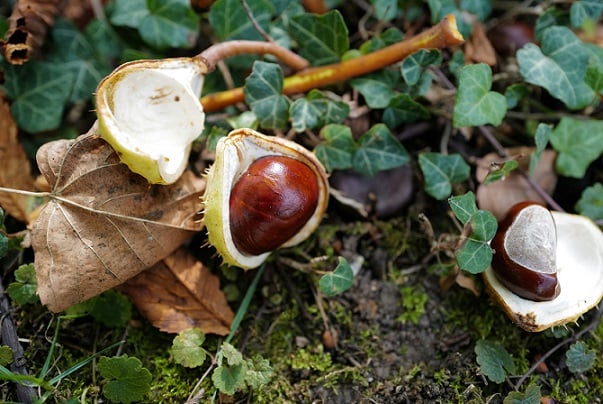Toxins Your Pet Should Avoid In Autumn

Autumn is a wonderful time of year for pets as well as people - leaves to chase, puddles to splash, muddy walks galore! However, the season also comes with a few health risks, particularly things your pet might accidentally eat. Our guide covers a few of the most common autumn toxins, symptoms to look out for and what to do if you think your pet has ingested one of these substances.
Horse Chestnuts (Conkers)Toxic ingredient: Aesculin The toxic ingredient in conkers is also found in the leaves and bark of the tree, so keep an eye out to make sure your pet doesn't eat these either. Conkers are also a choking hazards, and can potentially cause bowel obstructions if swallowed whole, which may require emergency surgery. Signs to look for in your pet include vomiting and diarrhoea, excessive drooling, excessive thirst or reduced appetite. In severe cases, ingestion can cause muscle tremors or seizures. |
 |
 |
AcornsToxic ingredient: Tannins Acorns are also a choking hazard and can cause intestinal damage if ingested whole. Signs of acorn poisoning to look for include vomiting, diarrhoea, abdominal pain and dehydration. In rare cases, untreated incidents of acorn poisoning have led to kidney and liver failure, so always speak to your vet as soon as possible if you suspect your pet has ingested acorns. |
Anti-freezeToxic ingredient: Ethylene Glycol One of the chemicals in anti-freeze, Ethylene Glycol, has a particularly sweet taste and smell. Cats especially, but also dogs, are drawn to it and may try to eat it if it is within reach. Ensure that if you use anti-freeze in your car, fasten the lid tightly and keep the bottle out of reach of pets. Symptoms of anti-freeze poisoning to look out for include vomiting, lethargy, difficulties with balance and coordination, seizures and laboured breathing. Once ingested, Ethylene Glycol is metabolised into calcium oxalate crystals which cause irreparable damage to the kidneys. This is rapidly fatal, so it's vital that if you suspect that your pet has ingested anti-freeze, take them to your vet immediately. |
 |
 |
ChocolateToxic ingredient: Theobromine (found in cocoa) With Halloween prompting an influx of chocolate in the house, it is fairly common for pets to try and sneak a taste. Dogs in particular are likely to try and eat chocolate, but it is also toxic to cats. The darker the chocolate and the higher concentration of cocoa (and therefore theobromine), the more severe the effects can be. Chocolate also contains caffeine, which is also unsafe for dogs and cats alike. Common symptoms of chocolate toxicity include vomiting and diarrhoea, increased thirst and urination, elevated heart rate and restlessness. Even if you only suspect your pet has ingested a small amount of chocolate, the negative affects still need to be addressed. Large amounts can be very dangerous, so either way it's best to speak to your vet for further instruction. If possible, have the packet available so the vet can calculate how much theobromine your pet has ingested. |
MushroomsToxic ingredient: Various The increase in rain during autumn can cause an influx of wild mushrooms, as they thrive in damp climates. You may come across them on walks, or they may appear in your garden. It can be very difficult to determine whether a particular mushroom is safe to eat, as many can look very similar but have very different toxicity levels. Symptoms to look out for include nausea, drowsiness, twitching and seizures. If you suspect your pet has ingested wild mushrooms, speak to a vet as soon as possible. Also, try and either take a sample or get a photo of the type of mushroom you think your pet may have ingested, as it may help the vet to identify the type of toxin and effectively treat it. |
|
In summary, it's always best to check with your vet if you're concerned in any way. It may be a false alarm, or that your pet has not ingested enough of a substance to be harmful, but if there is a risk of toxicity the sooner this is treated the more successful treatment is likely to be. It depends on the item eaten, but vomiting can usually be induced to empty the stomach if your pet is seen within 4 hours of eating something they shouldn't. It's also advisable to keep the contact details of your regular vet and your nearest emergency vet to hand. Save the numbers in your phone for when you're out on walks, keep a card with the details in your wallet or purse or stick them to the front of the fridge for easy access.
Disclaimer
Please note that the content made available on this webpage is for general information purposes only. Whilst we try to ensure that at the time of writing all material is up to date and reflects industry standards, we make no representation, warranties or guarantees that the information made available is up to date, accurate or complete. Any reliance placed by yourselves is done so at your own risk.


